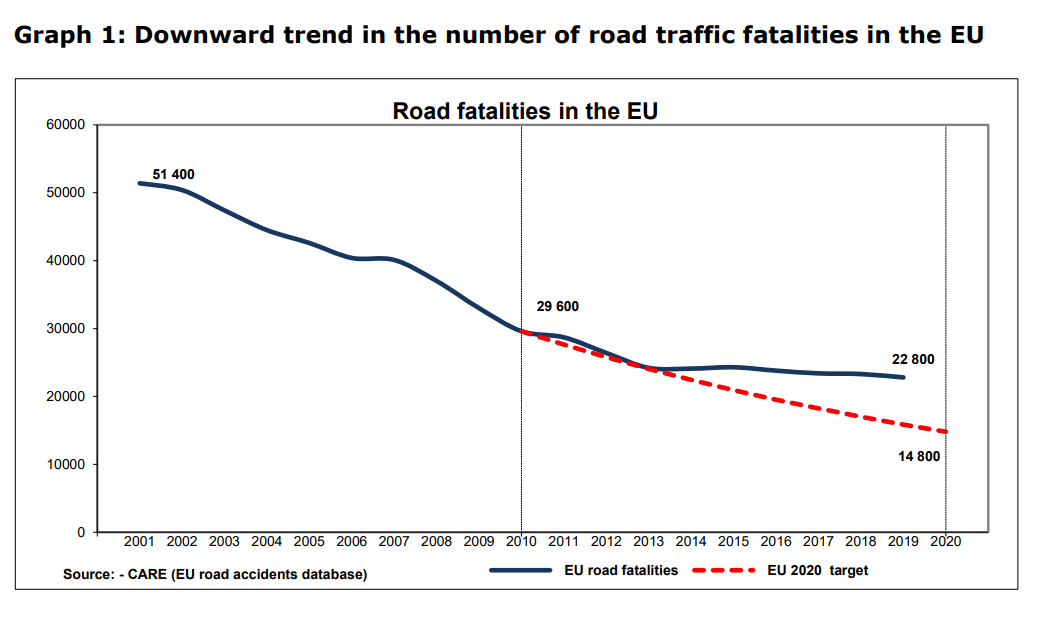
Cycling safety, sustainability, and how to reign in vehicle speed
On June 11, the European Commission released the latest statistics on the number of fatalities in road crashes across Europe. With fatalities falling 2% between 2018 and 2019 it is slightly more promising news even though we are still far from reaching the EU targets.
The reduction in road crash fatalities is welcome given the recent stagnation of the downward trend. There were 51,400 people killed on EU roads in 2001, and a steady decline to around 24,000 in 2013. However, from then until 2018 this figure had stubbornly refused to fall, with 25 100 fatalities in road accidents in the EU 28 in 2018.
2019 saw a fall to 22 800 and, once we have considered the UK leaving the EU, this is a fall of about 2%. Back in 2010 the EU target was a halving of fatalities by 2020 to 14,800 per year. These numbers from 2019 confirm a drop of only about 23%, but they also give us hope that this will not by any stretch of the imagination be happening!

We do not have the breakdown per mode yet, but we do know that improvements in cycling fatality figures have been even slower than other modes, with cycling fatalities falling only at 2% per year since 2010. Of course, we may have to consider that cycling numbers are rising as well, meaning increased exposure. How can we kick start a return to a fall in road fatalities that we had seen up until 2013, particularly for cyclists and pedestrians?
Safety by design
Interesting developments are the improvements in vehicle technology and the mandatory regulations that force car manufacturers to put these improvements in their vehicles. In Brussels, the General Safety Regulation which mandates these safety measures was finalised and approved at the end of last year.
The Commission proposal and the accompanying changes to the legislation proposed by Brussels could be ground-breaking with many vehicle safety measures specifically targeted at pedestrians and cyclists. These include Intelligent Speed Assistance; Advanced Emergency Braking systems to limit cars crashing into pedestrians and cyclists; Blind Spot Detection systems for HGVs/lorries; better Direct Vision for HGVs as well; and others. Many of the measures coming into force by 2022 (though unfortunately, HGV Direct vision will have to wait until 2026 for new models and 2029 for all new trucks sold.)
One of the most important safety features will be Intelligent Speed Assistance (ISA). The new General Safety Regulation mandates that every new vehicle by 2022 will have to be equipped with a form of ISA. It will have to make the driver aware of the limit “…through the accelerator control, or through dedicated, appropriate and effective feedback, that the applicable speed limit is exceeded”. The European Commission will start soon the work to define that system, and ECF will follow this topic closely.
The devil is in the details
Of course, the tricky bit is what is meant by “or through dedicated, appropriate and effective feedback”. We expect the vehicle manufacturers to attempt to weaken this as much as possible and claim that a flashing warning light or auditory buzz will be just as effective as the accelerator control.
So, it is with excellent timing that European transport Safety Council (ETSC) have commissioned a study by the University of Leeds. The study looked at 6 different types of ISA from systems that cut the engine’s power when over the limit to a simple flashing light in the dashboard. It included an analysis of how these systems impacted effectiveness and acceptance by drivers and it concluded by recommending three different types of ISA;
· “Speed Control Alone” – where the vehicle cuts engine torque once the speed limit is reached unless the driver deliberately overrides the system by pushing down substantially on the accelerator pedal.
· “Haptic Pedal” – in this variant, a system known as force-feedback makes it more difficult to push down on the accelerator pedal once the speed limit has been reached. Again, the system could be overridden by pushing down harder on the pedal.
· “Speed Control with Vibrating Pedal” – in addition to the speed control function outlined above, the accelerator pedal would vibrate once the speed limit had been exceeded.
Interestingly the worst performing system with regards to effectiveness and acceptance were the auditory and visual flashing light warning systems; drivers hated them and they were not really effective.
Transport Research Laboratory (TRL) estimate that this sort of system could save around 22,000 lives over the next decade. We, along with other organisations interested in implementing this life-saving and possibly revolutionary technology, will be pushing for a good, effective and pleasant to use the system.
Contact the author
Recent news!
Upcoming events
Contact Us
Avenue des Arts, 7-8
Postal address: Rue de la Charité, 22
1210 Brussels, Belgium









